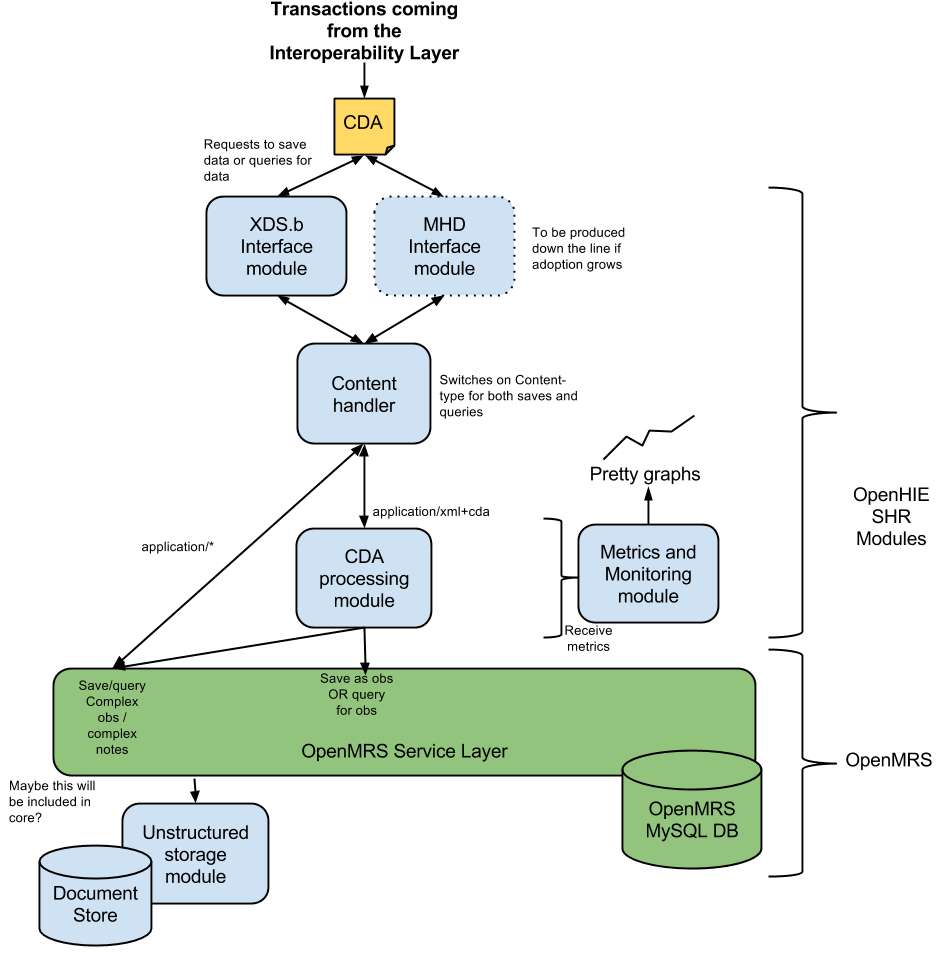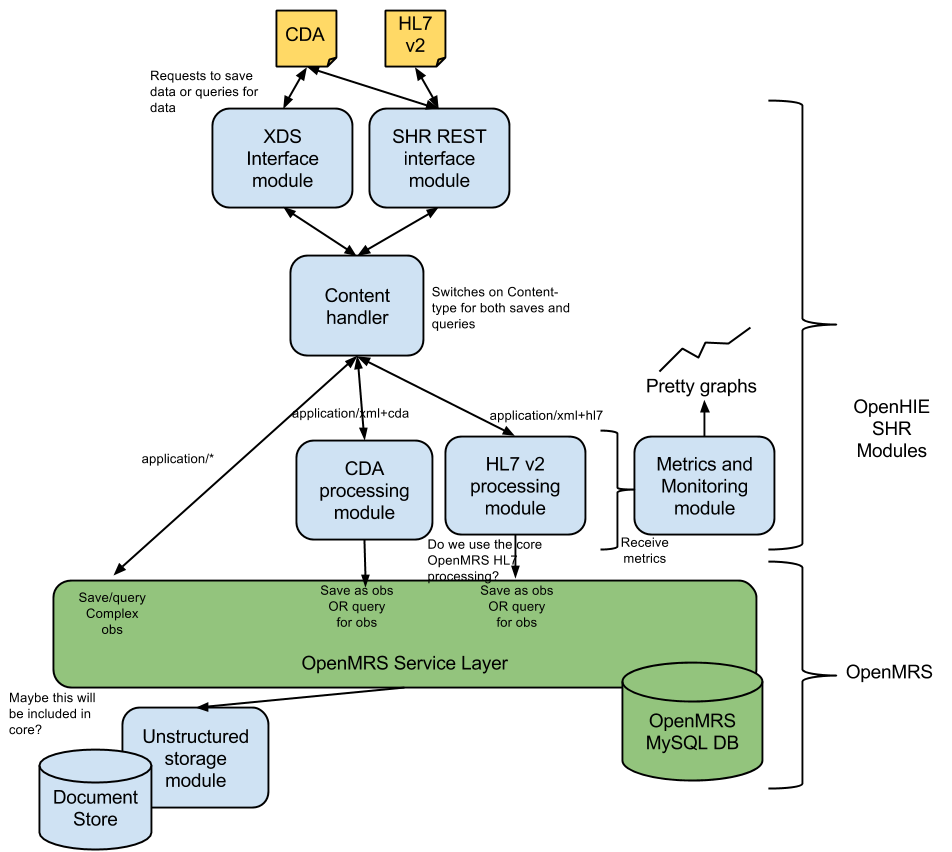The purpose of the Shared Health Record (SHR) software implementation is to provide a centralized repository for storing health data; with the goal of facilitating health information exchange among client systems. In line with the direction of the OpenHIE project, of which it this is a part of, the SHR does not aim to be a project-specific implementation of a Shared Health Record, but rather it aims to provide a framework and several core software components that can be used to implement a specific SHR.
This document will focus on the high-level architectural design for the SHR. Please refer to this document for the SHR requirements. The requirements themselves will be considered concluded within the scope of this document. For the Shared health Record component, we have decided to make use of OpenMRS as the core technology on which to build a solution. The review process that we went through to make this decision is described in the tool recommendation document. This design document will describe the modifications needed to allow OpenMRS to be used as an SHR for OpenHIE.
To design a Shared health Health Record (SHR) around the OpenMRS platform, we will need to modify OpenMRS to be able to perform the functions of an SHR. Some of the key changes that we will need to made make are as follows:
- Support the storage of unstructured data, e.g. documents such as CDA level 1 - 3
- Remove the user interface so that the SHR can run as a headless service (separate the service layer from the UI layer)
- Add standards-based interfaces to interact with the SHR, e.g. add endpoints for XDS.b + CDA or profiled HL7v2
- Add mechanisms for processing, storing and querying structured and unstructured data within OpenMRS
- Add hooks at various stages of the data life cycle for clinical decision support or data validation
- Make sure everything can be mapped to an encounter-based domain model
- Investigate solutions for allowing the OpenMRS SHR to scale horizontally
- Modify the database in order to optimize performance based on the SHR use case
- Modify OpenMRS fields and data model constraints in order to suit an SHR.
- Evaluate the encounter/obs tables against the ORUR01 schema, and discuss potential changes that will make our data model more hl7 compliant.
...
The following diagram describes the overall architecture of the components that would enable OpenMRS to act as a an SHR.
In the initial version of the SHR we would like to be able to revive receive data in 2 different message formats:
...
We would like to support CDA as the primary exchange format, however, we would also like to support a minimal set of HL7 v2 processing functions to allow legacy applications to send data in this format until such time as they are able to make use of CDA.
...
- The XDS.b IHE profile - this would be the entry point for CDA documents and the primary standards-based interface to receive clinical information.
- A simple REST interface - this would be a simple entry point to receive HL7v2 or CDA documents on.
Basic architecture
The basic architecture for allowing OpenMRS to become an SHR is to provide a number of modules that expose the interfaces that we need for the SHR and to allow us to process the data received and store this in the OpenMRS data model. Also, these modules must allow data to be retrieved from OpenMRS and formatted in standardised standardized message formats in the case where data need to be queried by clients.
...
- Interface modules - these modules provide the service interfaces to send and receive information using a particular standardised standardized interface.
- Content handler module - this module forwards received data to the appropriate processing module so that it can be stored.
- Processing modules - these modules provide the functionality to interpret data in a particular format and store/retrieve this to/from OpenMRS's data model.
We also consider monitoring as a first-class citizen and a module to monitor SHR performance is required. All other module modules are expected to report monitoring data to this module.
Interface Modules
Interface module modules provide service interfaces for an external application to call in order to get access to information in the SHR. These module modules MUST make use of the content handler module's getContentHandler(String contentType) method (see here) to handle any request to save data or to query data from the SHR.
As part of the default implementation of the SHR, we will implment implement some specific iterface interface modules. These are described below.
...
This module provides an XBS.b interface into OpenMRS. It is expected to receive any type of document payloads over the XDS.b interface and pass those on to the content handler with the content type of the payload.
For a the more detailed design of this component see: XDS.b interface module
...
This module is expected to provide a RESTful interface for receiving and querying HL7 v2 messages as well as CDA documentsCDA documents. In the future, it will conform to a subset of the RESTful FHIR specification which is planned to be used for the future IHE MHD profile once it is stable. It will pass the received data on to the content handler with the content type of the payload. However, for now, these specifications have not been completed and are not releases. As such we will produce a simple REST module in order to test the rest of the SHR architecture until such time as we have proper profiled specifications to develop against.
The design for this basic REST module can be found here: Simple SHR REST interface module
For the more detailed design of the MHD/FHIR module see: FHIR Document interface module (This will be updated as new specifications emerge)
Content Handler Module
This module receives data from the interface handler along with the content type of that data. Using this information it is expected to forward data to the appropriate processing module that can handle that data. It is also required to have the functionality to allow processing modules to be able to dynamically register and de-register their interest to data of particular content types.
For a the more detailed design of this component see: Content Handler Module
Processing Modules
Processing module modules are able to process data in a particular format to save in to into OpenMRS and to query OpenMRS for data and convert this to the supported format. Processing modules MUST implement the ContentHandler interface of the content handler module MUST register their content handler with the content handler module to make it available to other modules. See here for more details about the content handler module.
...
The HL7 v2 processing module is expected to process HL7 v2 messages and store these within OpenMRS's discrete data model. It should also provide functions to retrieve information from OpenMRS and construct this as a HL7 v2 messages as required. OpenMRS's relational database tables will be used to store this information and this can be stored and queried using the normal OpenMRS services.
Alternatives for HL7 V2 message processing
...
More information about HL7 processing concerns is at SHR HL7 processing issues.
...
The unstructured data
...
storage module
The unstructured data processing module is expected to be able to process any other data that cannot be interpreted by any of the other processing modules. It storage module is expected to be able to store and retrieve unstructured data as -is in blob form. This module is useful for handling unstructured information such as images or pdf's but may be able to store any information that cannot be processed by another processing modulea Complex Observation or a Complex Note. For a more detailed design see the Unstructured Data Processing Module.
Metric and Monitoring Module
...
In addition to the creation of these modules, there are some changes that we would like to make to OpenMRS itself:
- Remove the requirement to have to store patient names and date of birth as we would only want to store a patient identifier for an SHR
- Performs database modifications to improve performance for SHR functionality
- Add data lifecycle hooks for certain processes to hook into (for example clinical decision support functionality)
- Enable OpenMRS to be able to scale horizontally
- Develop encounter (and possibly obs) attributes as a means of storing additional information such as user-specified identifiers. The need for this is discussed in in more detail here.
- Discuss ways to improve Obs table performance (if possible). This should include alternatives other than scaling. Can changing the structure of the table / splitting it up to be of any use to us?

